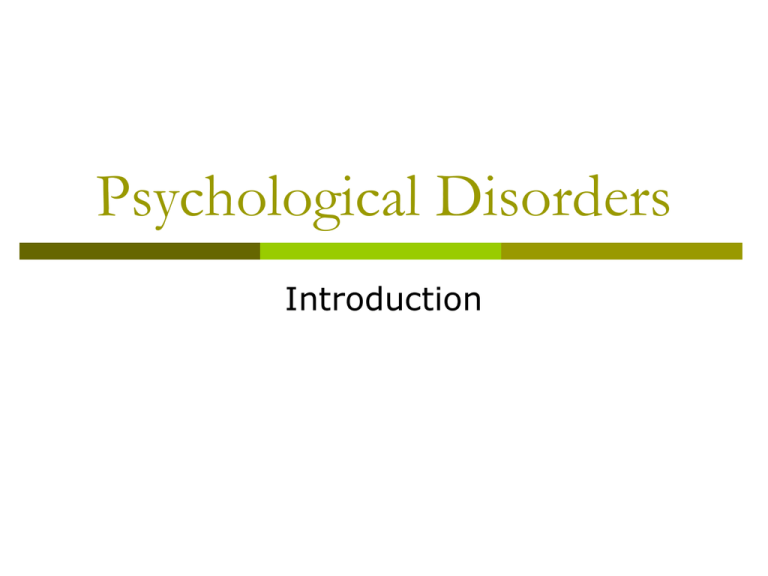Psychological Disorders
advertisement

Psychological Disorders Introduction What is ABNORMAL? Write about a time when you did something you thought was abnormal. Why did/do you consider this abnormal? Criteria of Abnormal Behavior Deviance Behavior that is outside the socially acceptable norms Varies among cultures Maladaptive Impairment of adaptive everyday behavior Interferes with social and occupational functioning Personal distress Self reported troubles; subjective pain and suffering Medical Models of Psychopathology: Look for BIOLOGICAL causes Diseases Neurotransmitter abnormalities Genetic factors Brain defects Treatments emphasize ORGANIC treatments Drugs Neurosurgery ECT, DBS, TMS Thomas Szasz - “Illness can affect only the body.” Problems with the medical model: Allows deviant behavior to be locked into conformity Labels are derogatory Forces those with a disorder to take a passive role as medical patient Psychological Models of Psychopathology: Look for PSYCHOLOGICAL causes Early life experiences Traumatic events Illogical thinking Maladaptive learning experiences Treatments emphasize PSYCHOLOGICAL treatment Psychoanalysis (Freudian approach) Psychotherapy (Cognitive and Humanistic approach) Behavior therapy (Classical/Operant Conditioning) Sociocultural Models of Psychopathology: Look for social and cultural influences on behavior Societal norms and expectations Sub-group influences Family dynamics Treatment emphasizes a “systems” approach Family therapy Couples therapy Group therapy Community interventions the Asylum 1950’s – the height of institutionalization David Rosenhan – “Being Sane in Insane Places” Classification of Disorders 1952 – first Diagnostic & Statistical Manual of Mental Disorders (DSM) 2013 – DSM-5 Anxiety and Anxiety-Related Disorders: DSM-5 recognizes 12 types Four common anxiety disorders include: Generalized Anxiety Disorder Panic Disorder Specific Phobia Social anxiety disorder Etiology of Anxiety Disorders: Biological factors: deficient GABA neurotransmitters (GAD/Panic) deficient serotonin (Social) respiratory abnormalities (GAD/Panic) Psychological and sociocultural harsh self-standards (GAD/Social) strict and critical parents (GAD/Social) automatic negative thoughts (GAD/Social) classically conditioned responses (Panic/Phobia) Related, but not classified as anxiety disorders: Obsessive-compulsive disorder overactive frontal cortex and basal ganglia deficient serotonin and dopamine levels inability to turn off negative thoughts OCD-related disorders added in DSM-5 Hoarding Excoriation Trichotillomania Body Dysmorphic Disorder Body Integrity Identity Disorder Post-Traumatic Stress Disorder: DSM-5 expands criteria Symptoms may vary, but often: flashbacks memory and concentration impulsive behavior excessive arousal response reduced affect Emotion and Mood Disorders: Depressive Disorders Major depressive disorder Persistent depressive disorder Biological factors genetics serotonin and norepinephrine Psychological factors learned helplessness self-defeating beliefs rumination pessimistic attribution style contagions Sociocultural SES gender Bipolar Disorder: Two extremes – mania and depression often cycles multiple times through depression and mania NOT extreme mood swings in a 24 hour period Biological factors Genetic link Norepinephrine and serotonin Glutamate Somatoform Disorders Somatization Conversion pain neurologic problems gastrointestinal complaints sexual symptoms paralysis blindness hearing loss loss of sensation or numbness Hypochondriasis Dissociative Disorders: Dissociative Amnesia Dissociative fugue Dissociative Identity Disorder Depersonalization Schizophrenia: Catatonic; Paranoid; Disorganized; Undifferentiated Psychosis Symptoms: Positive Hallucinations; delusions; disordered thought; referential thinking; word salad Negative Flat affect; inability to read emotions; deficient in planning and goal-behavior; catatonia Causes of Schizophrenia: Biological factors Structural brain abnormalities Problems with neurotransmitters Dopamine Psychological factors Diathesis stress model Diathesis Stress Model - THOMAS WIDIGER, UNIVERSITY OF KENTUCKY CLINICAL PSYCHOLOGIST “The patterns found in personality disorders really are traits that are distributed throughout the population, and we all have them to greater or lesser degree.” Treatment Methods Psychotherapy Insight Action Biomedical therapy Drugs Surgical procedures Psychoanalysis (Freudian Approach) Insight therapy Direct techniques Dream interpretation manifest content latent content Free association Examination of: Resistance Transference More likely to help… Anxiety disorders Somatoform disorders Dissociative disorders Humanistic Therapy/Approach Insight therapy Carl Rogers Real vs. Ideal self NON-directive Person-centered active listening Four key elements reflection unconditional regard empathy authenticity More likely to help… Individuals who can express their thoughts and feelings in a logical manner Cognitive Therapy/Approach Action therapy Albert Ellis Rational-emotive therapy More likely to help… Depression Stress disorders Anxiety disorders Some aspects of schizophrenia Main concepts: Disconfirmation Reconceptualization C.B.T. Distorted/Unhelpful Thinking Style Distorted/Unhelpful Thinking Style Distorted/Unhelpful Thinking Styles Behavior Therapy/Approach Action Therapy May be helpful… Abnormal behavior Eating disorders is not a symptom, Drug and alcohol addiction but a problem itself Phobias Behavior modification Classical Conditioning Operant Conditioning Behavior Therapy/Approach Classical Conditioning Operant Conditioning Systematic desensitization Participant modeling Aversion therapy Token economy Flooding Contingency contract Extinction techniques Biomedical Therapy/Treatment Psychopharmacology Antipsychotic drugs Antianxiety drugs MAOI, Tricyclic, SSRI Lithium Benzodiazepines – Xanax, Ativan, Valium Antidepressant drugs GENERALLY decrease dopamine levels Treats bipolar MANIC symptoms Electroconvulsive Therapy Depression, Mania, Schizophrenia






